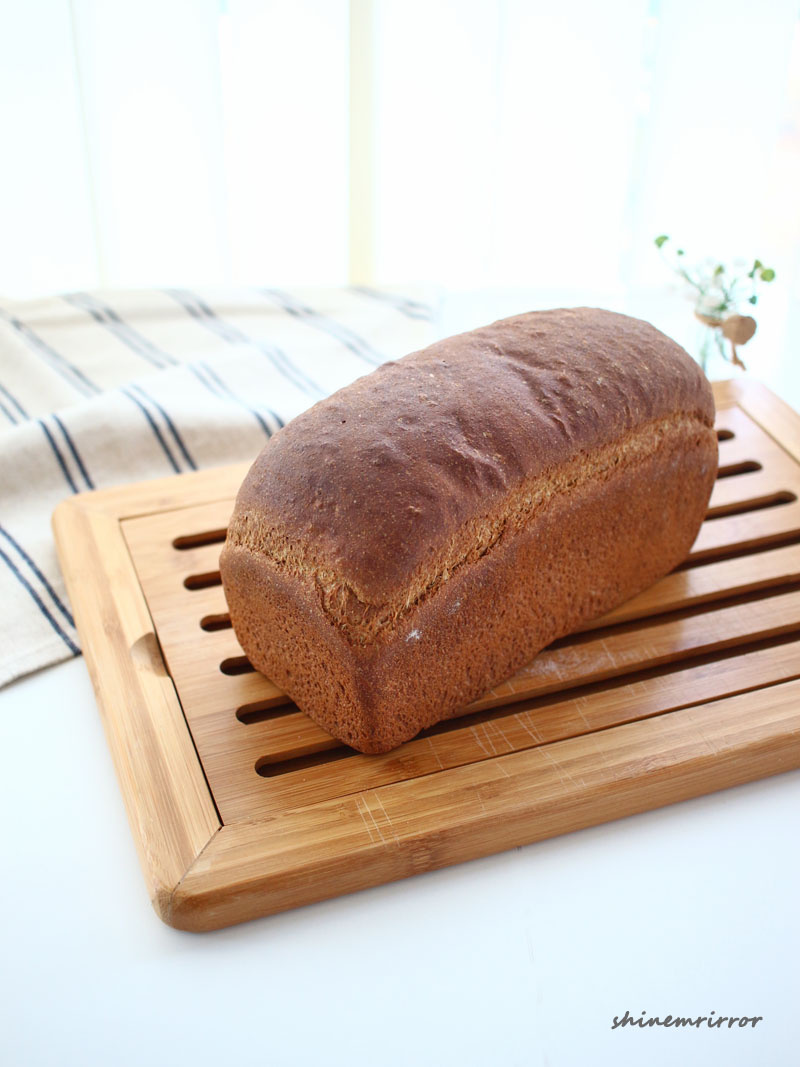Soft 100% Whole Wheat Bread
🍞 Deliciously Soft 100% Whole Wheat Bread Recipe | Beginner-Friendly!

Experience the joy of baking a 100% whole wheat bread that’s surprisingly soft and incredibly delicious! Because the dough ferments quickly, it’s crucial to watch out for over-proofing. Let’s bake this moist and chewy whole wheat loaf together!
Sponge (Pre-ferment)- 100g Bobs Red Mill Whole Wheat Flour
- 208g Warm Water (30-40°C / 86-104°F)
- 45g Molasses (or honey, maple syrup)
- 6g Instant Dry Yeast
Main Dough- 200g Bobs Red Mill Whole Wheat Flour
- 2/3 tsp Salt
- 25ml Grapeseed Oil (or vegetable oil)
- 1 tsp Lemon Juice
- 10-25g Water at room temperature (adjust as needed)
- 200g Bobs Red Mill Whole Wheat Flour
- 2/3 tsp Salt
- 25ml Grapeseed Oil (or vegetable oil)
- 1 tsp Lemon Juice
- 10-25g Water at room temperature (adjust as needed)
Cooking Instructions
Step 1
Let’s begin by preparing the ‘sponge,’ the foundation for our delicious whole wheat bread. In a large bowl, pour the warm water (around 30-40°C or 86-104°F) and dissolve the molasses (your sweetener) thoroughly. You can substitute with honey or maple syrup if preferred. Sprinkle the instant dry yeast over the mixture and let it sit for about 5 minutes. You’ll see the yeast sink as it begins to activate. Once activated, gently stir it into the water.

Step 2
Now, add the 100g of Bobs Red Mill Whole Wheat Flour to the sponge mixture. Using a spatula or your hands, mix until just combined and there are no dry pockets of flour. The type and amount of sweetener you use will affect the bread’s sweetness. Using about 2 tablespoons of molasses will yield a subtly sweet loaf. Feel free to adjust the sweetener to your liking.

Step 3
The sponge batter will be very loose and runny because the amount of water is more than double the flour. It will have a consistency very similar to water. This is perfectly normal for this stage.

Step 4
Checking the temperature of the batter, it’s around 27-28°C (81-82°F), which is ideal for fermentation.

Step 5
Now, let the sponge batter rise in a warm place (around 25-30°C or 77-86°F) for about 1 hour, or until it has tripled in volume. The warmer the environment, the faster it will ferment. It’s okay if it slightly over-proofs and slides down the side of the bowl, but aim for a good three-fold rise. Even though it looks very liquidy, you’ll be surprised to see it bubble up nicely!

Step 6
Next, we’ll prepare the ‘main dough.’ In your stand mixer, combine the sponge mixture with all the main dough ingredients except for the room temperature water (10-25g). Start mixing on low speed. You’ll need to carefully monitor the dough’s consistency and adjust it to be soft and pliable. If the dough feels too stiff, gradually add the reserved room temperature water until it reaches the desired texture.

Step 7
Using a Kenwood mixer, I kneaded the dough on speed 1 for about 3 minutes. This initial kneading helps to incorporate all the ingredients evenly.

Step 8
After the initial 3 minutes of kneading, leave the dough in the mixer bowl, covered, for a resting period of about 5 minutes. This rest helps the gluten to relax and makes the dough more manageable.

Step 9
Now, continue kneading on a medium speed (around speed 1.5-2 on my mixer) for another 5-8 minutes. I kneaded for about 7 minutes. At first, the soft dough might stick to the bottom of the bowl and appear messy, but as you continue kneading, it will gradually come together, forming a cohesive and smooth ball of dough. Be patient, as 100% whole wheat dough can take a bit longer to develop gluten.

Step 10
The final dough temperature after kneading was 24-25°C (75-77°F), which is perfect for the next stage.

Step 11
Gently shape the dough into a smooth ball and place it in a lightly oiled bowl. Cover with plastic wrap or a damp cloth and let it rest at room temperature (22-24°C or 72-75°F) for 15-20 minutes. This is called ‘bench resting’ and allows the gluten to relax before shaping.

Step 12
After the bench rest, the dough should have increased in size by about 1.5 to 2 times. You’ll notice its characteristic whole wheat density.

Step 13
Turn the dough out onto a lightly floured surface. Gently press down with a rolling pin to degas it, being careful not to press too hard. Shape the dough into a log by rolling it up tightly. (This step helps the dough rise evenly during the final proof).

Step 14
Place the shaped dough into a greased cornmeal loaf pan. Cover the pan with a lid or plastic wrap to prevent the dough from drying out. Allow it to proof at room temperature (around 25-30°C or 77-86°F) for 50-60 minutes, or until the dough has risen to fill the pan. If using a different pan, aim for the dough to double in volume.

Step 15
My final proof took about 30 minutes in a 24-26°C (75-79°F) environment. Be mindful that preheating the oven while the dough is proofing can lead to over-proofing, so it’s best to start preheating once the dough is nearly ready. Bake in a preheated oven at 160°C (320°F) for 30-35 minutes (using a Smeg oven as a reference). Once baked to a beautiful golden brown, carefully remove the bread from the pan and let it cool completely on a wire rack. Enjoy your homemade, soft 100% whole wheat bread!




